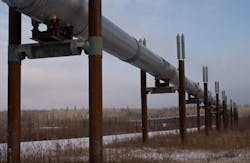US infrastructure projects to draw significant investments in 2013
As production of oil and gas in the United States is reaching new levels, billions of dollars are going to be invested in the development of infrastructural projects such as pipelines to help the country use its energy potential to the maximum extent.
The pipelines that are currently available in the country cannot serve the newly developed production areas in the central parts of the United States, like North Dakota and Texas, and are unable to transport the production across the whole continent, the Wall Street Journal reported. With the lack of suitable infrastructure to transport fuel, companies have been forced to come up with creative and long-forgotten ways to get it to the markets, such as using barges and trains.
Over the past couple of years, the number of tugboats sailing along the Mississippi river pulling barges loaded with fuel has risen, and so has the number of oil-carrying tanker trains. Meanwhile, some of the existing pipelines that were used for transportation of crude north from the Gulf Coast are being converted to allow flow of oil southward to refineries located there.
According to Joseph Stanislaw, an independent senior energy adviser to Deloitte consultancy, the U.S. infrastructure has been built based on the concept that the country would mainly rely on imports. However, as domestic production has boomed, the country has been given the opportunity to meet all its demands but existing infrastructure proves incapable of delivering the production, he added.
In order to deal with this problem, the United States needs to upgrade and reform its logistics. A prediction by AECOM Technology Corporation, a firm that specializes in industrial project design, says that some $45 billion could be invested in constructing new or redeveloping existing infrastructure next year. Projects include building pipelines and investing in rail cars and terminals, among others, AECOM senior vice president Seth Deutsch told the Wall Street Journal.
The lack of suitable infrastructural projects prevents many U.S. companies to benefit from cheap domestic production. A barrel of crude produced in Oklahoma and purchased at a key distribution hub could cost $27 less than any barrel imported from any given point across the globe.
Railroad transport has so far allowed Valero Energy Corporation, the world's biggest independent refiner, to be shipping 40,000 barrels a day from North Dakota to its refinery in Memphis, Tennessee, using a combined rail and pipeline route. Bill Day, spokesman for the company, said that it has been sending crude to a number of locations, with current plans predicting large-scale shipments of oil to California.
Although using rail transport is usually more expensive than pipelines, it has been a preferred method because of the legal constraints and environmental concerns that can prevent the construction of pipelines. This is just one more reason to focus the attention of investors on transforming existing pipelines, the Wall Street Journal pointed out. Businesses like Enterprise Products Partners and Enbridge Incorporated have already completed their projects on reversing the Seaway Pipeline, so that it can transport oil to Texas rather than north to Oklahoma. The fact that the facilities are already in place would be an appealing aspect for investors, the article concluded.
